-
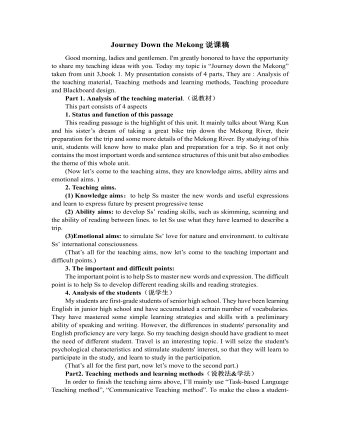
人教版高中英语必修1Journey Down the Mekong说课稿
2. let the Ss complete the forms paragraph by paragraph. Purpose here is to help Ss to get the habit of reading a passage as a whole, and pay attention to the organization of the text, as a result the Ss will fully understand the whole passage.3. ask Ss to retell the passage with the help of the key words in the form.Since the Ss in the class are in different levels, so I let them to fill in the blank to understand the meaning of the words and phrases better. ( That’s all for the while-reading. Now let’s move to the fifth step.)Step V: Post-reading (10mins) ---DiscussionIn this part students are asked to discuss in groups and list Wang Kun’s and Wang Wei’s attitudes about the trip. After that, Ss are encouraged to express their attitudes with the whole class. Collect their answers and don’t forget to praise them even if their answers may not be perfect.In this activity, discussion provides a vivid and active learning environment for Ss to communicate in English with newly learned language items. (Finally it comes to the homework.)StepⅥ: Homework (1min)1. Ss are required to read the text again after class and figure out the meaning of some complex sentences.2. Do the exercises on P19; This can help Ss to consolidate what they’ve learnt and make preparation for the next lessonPart4. Blackboard design.(说板书设计)On the top, there is the title of this lesson. On the left, there are main ideas for each paragraph. On the right, there are some new words and expressions.Unit 3 Travel journalJourney down the MekongMain idea of each para.:Para1: deciding to take a great bike trip along the Mekong river.Para2: Different attitudes between Wang kun and Wang wei.
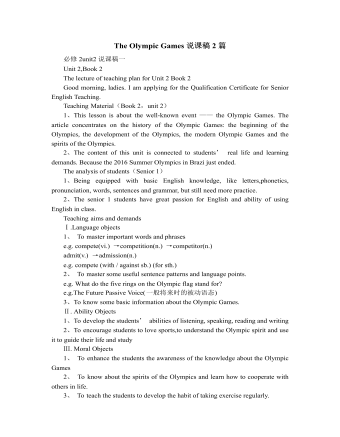
人教版高中英语必修2The Olympic Games说课稿2篇
Purpose of my design:To ask the students to do these two tasks will make the Ss predict the story of this passage. As a result, it will deepen Ss’ memory of this story because they will have their own understanding of this story.Step 3. While-readingTask 1. (Individual work _____min)Skimming: ask students to skim the text and the main ideas of each paragraph in this passage. Please read it quickly and then match the sentences with the letters.Task 2. (Individual work _____min)Scanning: read the text quickly and decide the whether the following statements are true or false and give reasons.Task 3. (Pair work _____min)Listen to the tape and fill in the banks. Then read the paragraph with expression to your partner.Task4 (individual work min)Listen to the tape again and write down the main idea in one sentence.Purpose of my design: Enable students to understand the given material better by using different reading skills. And proper competition can arouse the Ss’ interest in English learning. “Task-based” teaching method is used here todevelop the Ss’ ability of communication and also their ability of co-operation will be well trainedStep 4. Post-readingTask 1. (Individual work, pair work, group work, class work; _____min)Discussion (group of 4):1. If you were Hippomenes, would you run against Atlanta?2. Do you think Hippomenes deserved to win the race? Why or why not?Step 5. HomeworkPlease read the story again carefully after class and imagine: What will happen during the race between Hippomenes and Atlanta? Who do you think will win the race? Do you think Atlanta would marry Hippomenes? Write an end for the story with thses questions.Purpose of my design: Homework is so important and necessary for to master the knowledge they learned after class. It will check whether the Ss achieve the teaching aims.Part 5 Blackboard design
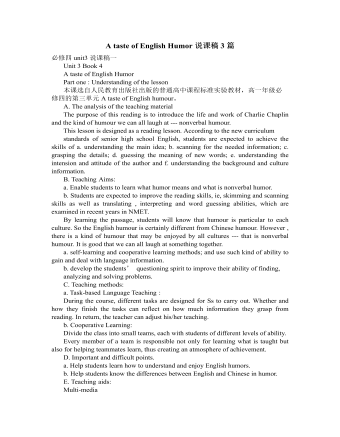
人教版高中英语必修4A taste of English Humor说课稿3篇
Then I would ask them to think of a funny English or Chinese and tell it to partners. While telling stories, they can use expressions and some acting to help make the story funny. 5 minutes would be given to do this.Those stories they told there will be the material for their writing. Soletting them tell it at first is helpful. And they can make a difference between telling a funny story and writing it down. Generally speaking, it is difficult forstudents to write well because they don’t know what to write and how to write. Asking them to tell their own stories at first can help them come up with what to write.After their telling, I would invite someone to share his/her story with all of us and I would write it down on the blackboard.This example story would be used as a sample to illustrate the format of funny story. Different from a story from teacher or textbook, a story from students can obviously become a interesting material to draw students’ attention.Then I would ask the whole class to put this story into several parts. It might be a little bit difficult for them. So I would ask them to find out whether all the sentences are necessary. After delete some sentences, there are 6 sentences left behind. Then they can easily put them into three parts. After interaction with students, I would teach them the right terms for each part and conclude the format of funny story.This step is the key and difficult point in my lesson. So I mainly usetask-based teaching method in this part and the task for students was divided into several stages. With the separated difficult level, students can find there are usually three parts in writing. They can also learn to write without the unnecessary parts in the process of analyzing. And then I wouldn’t rush to tell them the right terms to them directly. Instead, I would ask them to name them by their own. A confused mind is better for acquiring knowledge.While-writing:Then I would give students 7 minutes to write down this story, without other requirements.With all the preparations in pre-writing, students’ difficulties were cleared. So it would be much easier for them to write down the story within 7 minutes. There are no other requirements because students’ first writing is actually a drafting. It would be revise and edit several times later. Writing, as a skill
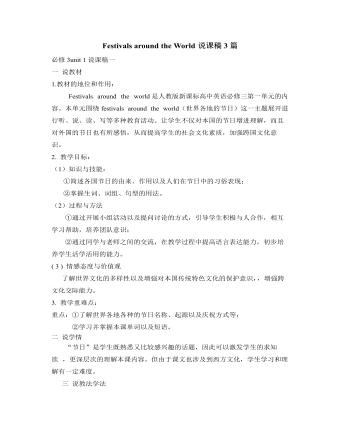
人教版高中英语必修3Festivals around the World说课稿3篇
Teaching plan for Unit 1 book3Good morning, teachers. It’s my great pleasure to be here because I can share my lesson with you and I can learn a lot from it. I’ll begin my lesson from the following four parts, the teaching material, the teaching methods, the studying methods and the teaching procedure.Firstly, let me talk about the teaching material. The content of my lesson is the reading passage festivals and celebrations of Unit 1 Festivals around the world. This passage is about festivals and celebrations. By studying this passage, we’ll enable the students to know that festivals exit everywhere, and many of festivals in different countries celebrate similar ideas. As we all know, the reading passage is the center of each unit. If the Ss can learn it well, it will be helpful to make the Ss learn the rest of this unit.After studying the teaching material, I think the teaching aims are as the followings:1. Knowledge aims:(1) The Ss can master the usage of the important words andexpressions.(2)The Ss can use the __________________ (grammar) in the proper situation.Make students know about the festivals all over the world and the detail of the festivals, such as origin, content, and the date of the holiday festivals.2. Ability aims:(1) Students can talk about festivals and celebrations in English(2) To improve the student’s reading ability, especially their skimming and scanning ability.3. Emotion aims:Make the Ss know about the foreign festivals, and respect other countries’ custom.Next, let’s come to the important points and the difficult points.The important point is how to make the Ss understand the text better and the difficult point is how can they talk about it. secondly, Teaching Methods:1. task-based Language Teaching2. Computer assisted language teaching.3. question-and–answer methodThirdly, Studying Methods:
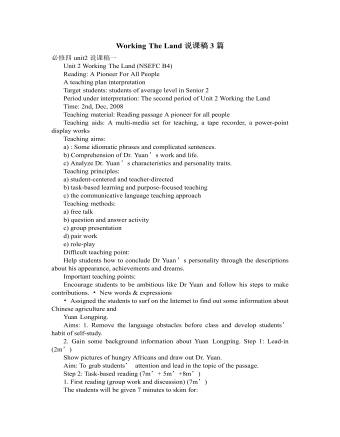
人教版高中英语必修4Working The Land说课稿3篇
Knowledge objectives:(1) to make Ss grasp the usage of words, expressions and sentence structures: statistics, struggle, thanks to, rid of, some patterns for persuasion, the “ing” form as subject and object;(2)to use learnt knowledge to persuade sb.Ability objectives:(1) to develop Ss’ reading skills(skimming, scanning, word guessing);(2) to improve Ss’ speaking, communicating and cooperating skills.Emotional objectives:to make Ss know the contribution of Yuan,and learn his spirit and his simple life time.Teaching important and difficult points:(1) some words, expressions and sentence structures mentioned above;(2)the content of the text;(3)training their reading and speaking skills.Teaching methods: CLT, TBLT,QT.Learning strategies: CLS, QLS, TBLS.Teaching procedures:Step 1 lead-in: (1) teacher plays a piece of recent news from CCTV about the harvest of the super hybrid rice, and ask students whether they know Yuan or not, and talk about him and his contribution.(2)Brain storm: let Ss describe Yuan in their minds including his appearance, his living condition and so on.Step 2 fast reading tasks:(1)teacher introduces Yuan and super hybrid rice(2)make Ss read the text as fast as possible with questions. Such as: what’s the general ideaof this passage? What’s Yuan’ dream? (skimming and scanning skill)Step 3 intensive reading tasks(1)let Ss read the text silently, find topic sentence of each paragraph and draw the difficult sentences and the knowledge what they don’t understand.(words guessing)(2)teacher and Ss talk about the important words, expressions and sentences together, and ask Ss to retell the content of the text.(summarizing and paraphrasing)(3)teacher summarize this part.(4) read again following the courseware.
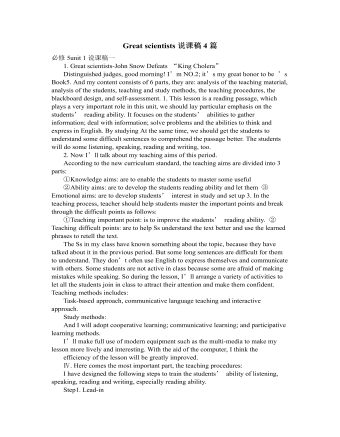
人教版高中英语必修5Great scientists说课稿4篇
通过写文章梗概,培养学生综合运用语言的能力,学习用恰当的英语描述科学家的故事。这是本课的教学难点。教师可以使用完形填空的方式来帮助学生整理语篇,从而来降低难度。本课的教学重点的突破方法是:在阅读前,让学生初步了解得出科学观点所需要的基本程序,从而轻松而自然地导入文章的阅读;在阅读过程中,由易到难设计快速阅读和精读的问题,层层推进各种阅读活动,让学生对阅读内容从整体感知到细节理解,最后深层读懂整篇文章,同时加强阅读策略的指导,让每个学生都主动参与课堂教学活动,最终达到提高阅读能力的目的。Step 4 Post-readingGroup Activities四人小组共同合作,在老师的适当指导下,就以下2个问题展开讨论,让学生就所知、所学、所感和所想融入话题,然后抽若干同学代表作小组发言。1. What do you think about John Snow, and what should we learn from him?2. Cholera was 19th century disease, which two diseases are similar to cholera today? Why?
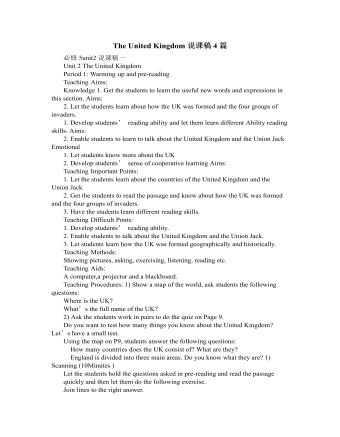
人教版高中英语必修5The United Kingdom说课稿4篇
Teaching Aims:Knowledge 1. Get the students to learn the useful new words and expressions in this section. Aims:2. Let the students learn about how the UK was formed and the four groups of invaders.1. Develop students’ reading ability and let them learn different Ability reading skills. Aims:2. Enable students to learn to talk about the United Kingdom and the Union Jack Emotional 1. Let students know more about the UK2. Develop students’ sense of cooperative learning Aims:Teaching Important Points:1. Let the students learn about the countries of the United Kingdom and the Union Jack2. Get the students to read the passage and know about how the UK was formed and the four groups of invaders.3. Have the students learn different reading skills.Teaching Difficult Ponts:1. Develop students’ reading ability.2. Enable students to talk about the United Kingdom and the Union Jack.3. Let students learn how the UK was formed geographically and historically.Teaching Methods:Showing pictures, asking, exercising, listening, reading etc.Teaching Aids:A computer,a projector and a blackboard.Teaching Procedures: 1) Show a map of the world, ask students the following questions:Where is the UK?What’s the full name of the UK?2) Ask the students work in pairs to do the quiz on Page 9.Do you want to test how many things you know about the United Kingdom? Let’s have a small test.Using the map on P9, students answer the following questions:?How many countries does the UK consist of? What are they??England is divided into three main areas. Do you know what they are? 1) Scanning (10Minutes )Let the students hold the questions asked in pre-reading and read the passagequickly and then let them do the following exercise.Join lines to the right answer.
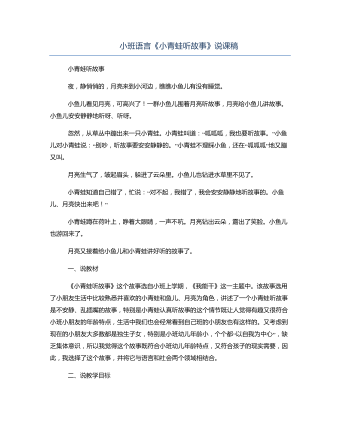
小班语言《小青蛙听故事》说课稿
小青蛙听故事夜,静悄悄的,月亮来到小河边,瞧瞧小鱼儿有没有睡觉。小鱼儿看见月亮,可高兴了!一群小鱼儿围着月亮听故事,月亮给小鱼儿讲故事。小鱼儿安安静静地听呀、听呀。忽然,从草丛中蹦出来一只小青蛙。小青蛙叫道:“呱呱呱,我也要听故事。”小鱼儿对小青蛙说:“别吵,听故事要安安静静的。”小青蛙不理睬小鱼,还在“呱呱呱”地又蹦又叫。月亮生气了,皱起眉头,躲进了云朵里。小鱼儿也钻进水草里不见了。小青蛙知道自己错了,忙说:“对不起,我错了,我会安安静静地听故事的。小鱼儿、月亮快出来吧!”小青蛙蹲在荷叶上,睁着大眼睛,一声不吭。月亮钻出云朵,露出了笑脸。小鱼儿也游回来了。月亮又接着给小鱼儿和小青蛙讲好听的故事了。
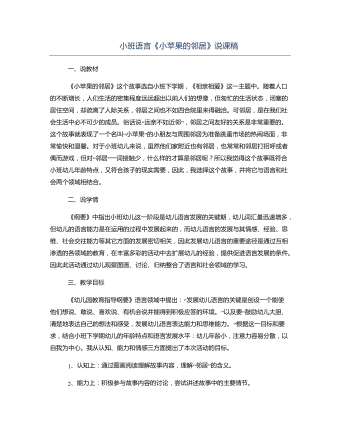
小班语言《小苹果的邻居》说课稿
《小苹果的邻居》这个故事选自小班下学期,《相亲相爱》这一主题中。随着人口的不断增长,人们生活的密集程度远远超出以前人们的想像,但匆忙的生活状态,闭塞的居住空间,却疏离了人际关系,邻居之间也不如四合院里来得融洽。可邻居,是在我们社会生活中必不可少的成员。俗话说“远亲不如近邻”,邻居之间友好的关系是非常重要的。这个故事就表现了一个名叫“小苹果”的小朋友与周围邻居为准备跳蚤市场的热闹场面,非常愉快和温馨。对于小班幼儿来说,虽然他们家附近也有邻居,也常常和邻居打招呼或者偶而游戏,但对“邻居”一词接触少,什么样的才算是邻居呢?所以我觉得这个故事既符合小班幼儿年龄特点,又符合孩子的现实需要,因此,我选择这个故事,并将它与语言和社会两个领域相结合。
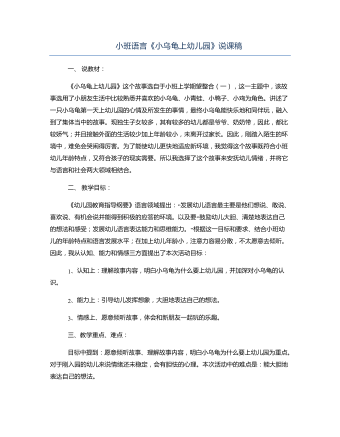
小班语言《小乌龟上幼儿园》说课稿
《小乌龟上幼儿园》这个故事选自于小班上学期望整合(一),这一主题中,该故事选用了小朋友生活中比较熟悉并喜欢的小乌龟、小青蛙、小鸭子、小鸡为角色。讲述了一只小乌龟第一天上幼儿园的心情及所发生的事情,最终小乌龟能快乐地和同伴玩,融入到了集体当中的故事。现独生子女较多,其有较多的幼儿都是爷爷、奶奶带,因此,都比较娇气;并且接触外面的生活较少加上年龄较小,未离开过家长。因此,刚踏入陌生的环境中,难免会哭闹得厉害。为了能使幼儿更快地适应新环境,我觉得这个故事既符合小班幼儿年龄特点,又符合孩子的现实需要。所以我选择了这个故事来安抚幼儿情绪,并将它与语言和社会两大领域相结合。
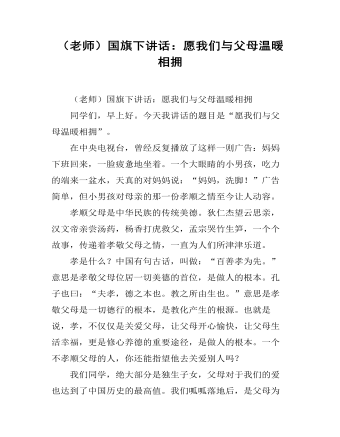
(老师)国旗下讲话:中学生要学会宽容与原谅
宽容是一种美好的情怀。深邃的天空容忍了雷电风暴的肆虐,才有风和日丽;辽阔的大海容纳了惊涛骇浪的猖獗,才有浩淼无垠;苍莽的森林忍耐了弱肉强食的规律,才有郁郁葱葱。大自然给了我们宽容的启示,而古往今来的无数经典事例,更是告诉了我们宽容的非凡价值。“吾所以为此者,以先国家之急而后私仇也!”蔺相如对廉颇的回避与退让,维系了赵国的安全与稳定,也成就了“负荆请罪”的千古佳话;“千里修书只为墙,让他三尺又何妨?”六尺巷的故事体现了张英的宰相肚量,更铸就了“化干戈为玉帛”的礼让美名;“生我者父母,知我者鲍子也。”鲍叔牙对管仲的体谅与举荐成就了齐桓公的霸业,更留下了管鲍之交的友情典范。楚庄绝缨,赢得了战场上舍身救己的忠诚将领;刘秀烧信,收获了前朝旧臣的赤胆忠心。宽容与原谅,不仅给了别人自我反省的机会,也构筑了人际关系的和谐平台。

教师教学工作常规管理制度
(二)小学教育是基础教育,基础教育要全面实施素质教育。在教学中,教师要把教书和育人和谐统一起来,不仅要求学生学好“双基”,发展“智能”,而且要促进学生思想、品德、兴趣、意志、行为、习惯的健康发展,全方位地实施素质教育。 (三)教学过程的基本环节有:备课、上课、作业布置与批改、辅导、考查与考试以及与此相关的工作计划和总结。任课教师必须着眼全过程,把握好每个环节,步步落实,勇于创新,优化教学过程,创造优质教学效果。 (四)教学是教师与学生的双边活动。在教学活动中,教师要遵循主体性原则,在充分发挥教师主导作用的同时,充分发挥学生的主体作用,形成教与学的互动,师与生的默契,既要关注每一位学生个体的成长,又要注重“培优辅差”;既保证全面发展,又要注重发展个性特长。 (五)各学科之间要统筹兼顾、互相照应、适时调控、减轻作业负担。 (六)学校要按国家教育部制订的课程计划,开齐课程、开足课时,控制周活动总量。根据寄宿制学校的特点,增开的校本课程(如口语、艺术、古诗文诵读等)和兴趣活动须在课程表上标明。学生兴趣活动和体育锻炼时间,任何学科不得挤占。 二、备课 (七)备好课是上好课的前提,不备课者不得上课。不备课而上课者或用旧教案上课者应作渎职行为处理。不认真备课者,应予以批评和处罚。
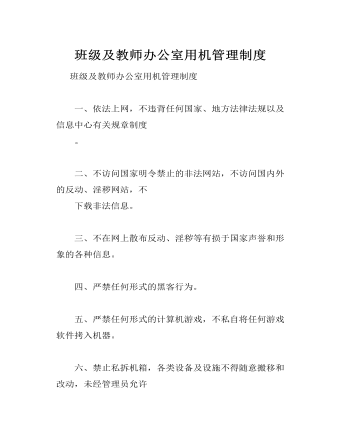
班级及教师办公室用机管理制度
二、不访问国家明令禁止的非法网站,不访问国内外的反动、淫秽网站,不 下载非法信息。 三、不在网上散布反动、淫秽等有损于国家声誉和形象的各种信息。 四、严禁任何形式的黑客行为。 五、严禁任何形式的计算机游戏,不私自将任何游戏软件拷入机器。 六、禁止私拆机箱,各类设备及设施不得随意搬移和改动,未经管理员允许 ,不能将任何机房物品、设备、部件携带出校门。 七、不准乱接乱拉电线、私自加接电源和其他设备。严禁吸烟,严禁使用明 火。 八、使用时请按要求进行登记,如需预约,请提前两个工作日与网络管理中 心联系。 九、未经管理人员允许,不随意删除计算机内资源。
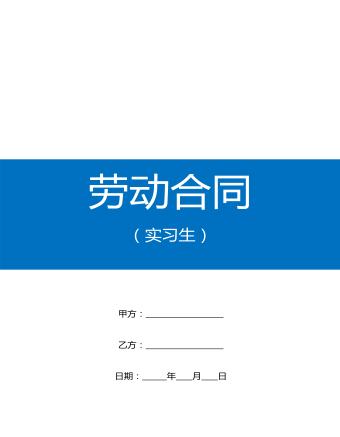
实习生劳动合同范本WORD
一、协议期限本协议自_______年_____月_____日起至_______年_____月_____日止。 二、实习岗位甲方根据乙方的实际情况和工作需要,安排实习学生到___________岗位实习,乙方应按学校的教学内容及实习要求,努力完成实习任务。 三、实习津贴依照按劳取酬的原则,按甲方现行制度确定实习生的实习津贴。具体支付方法如下:实习津贴:元/月,其他补贴:根据实习生在岗工作表现,以奖金形式发放。
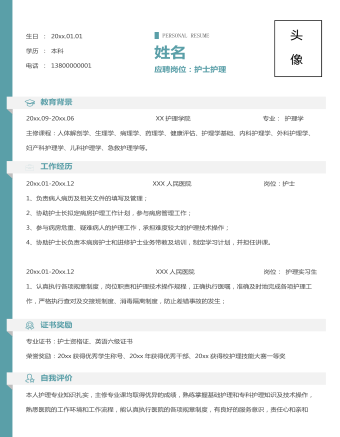
简约护士护理个人求职简历
20xx.01-20xx.12 XXX人民医院 岗位:护士 1、负责病人病历及相关文件的填写及管理;2、协助护士长拟定病房护理工作计划,参与病房管理工作;3、参与病房危重、疑难病人的护理工作,承担难度较大的护理技术操作;4、协助护士长负责本病房护士和进修护士业务带教及培训,制定学习计划,并担任讲课。20xx.01-20xx.12 XXX人民医院 岗位: 护理实习生 1、认真执行各项规章制度,岗位职责和护理技术操作规程,正确执行医嘱,准确及时地完成各项护理工作,严格执行查对及交接班制度、消毒隔离制度,防止差错事故的发生;2、做好患者的基础护理和心理护理工作,及危重患者的抢救工作及各种抢救物品、药品的准备、保管工作;3、经常巡视病人,密切观察记录危重患者的病情变化,如发现异常情况及时处理并报告。
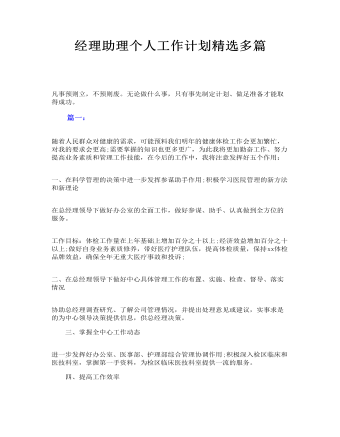
经理助理个人工作计划精选多篇
一、在科学管理的决策中进一步发挥参谋助手作用;积极学习医院管理的新方法和新理论 在总经理领导下做好办公室的全面工作,做好参谋、助手、认真做到全方位的服务。 工作目标:体检工作量在上年基础上增加百分之十以上;经济效益增加百分之十以上;做好自身业务素质修养,带好医疗护理队伍,提高体检质量,保持xx体检品牌效益,确保全年无重大医疗事故和投诉;
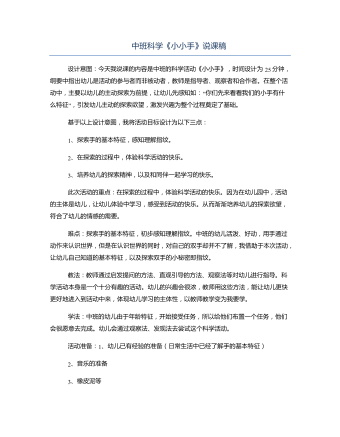
中班科学《小小手》说课稿
设计意图:今天我说课的内容是中班的科学活动《小小手》,时间设计为25分钟,纲要中指出幼儿是活动的参与者而非被动者,教师是指导者、观察者和合作者。在整个活动中,主要以幼儿的主动探索为前提,让幼儿先感知如:“你们先来看看我们的小手有什么特征”,引发幼儿主动的探索欲望,激发兴趣为整个过程奠定了基础。基于以上设计意图,我将活动目标设计为以下三点:1、探索手的基本特征,感知理解指纹。2、在探索的过程中,体验科学活动的快乐。3、培养幼儿的探索精神,以及和同伴一起学习的快乐。
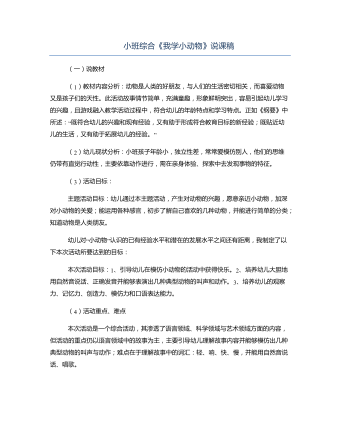
小班综合《我学小动物》说课稿
(1)教材内容分析:动物是人类的好朋友,与人们的生活密切相关,而喜爱动物又是孩子们的天性。此活动故事情节简单,充满童趣,形象鲜明突出,容易引起幼儿学习的兴趣,且游戏融入教学活动过程中,符合幼儿的年龄特点和学习特点。正如《纲要》中所述:“既符合幼儿的兴趣和现有经验,又有助于形成符合教育目标的新经验;既贴近幼儿的生活,又有助于拓展幼儿的经验。”(2)幼儿现状分析:小班孩子年龄小,独立性差,常常爱模仿别人,他们的思维仍带有直觉行动性,主要依靠动作进行,需在亲身体验、探索中去发现事物的特征。(3)活动目标:主题活动目标:幼儿通过本主题活动,产生对动物的兴趣,愿意亲近小动物,加深对小动物的关爱;能运用各种感官,初步了解自己喜欢的几种动物,并能进行简单的分类;知道动物是人类朋友。
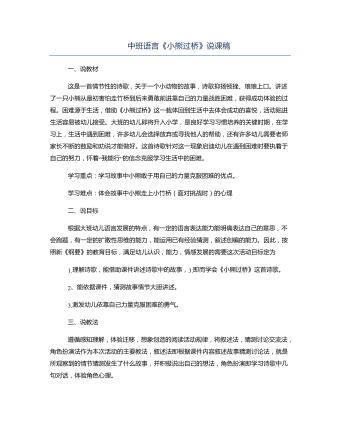
中班语言《小熊过桥》说课稿
这是一首情节性的诗歌,关于一个小动物的故事,诗歌抑扬顿挫、琅琅上口。讲述了一只小熊从最初害怕走竹桥到后来勇敢前进靠自己的力量战胜困难,获得成功体验的过程。困难源于生活,借助《小熊过桥》这一载体回到生活中去体会成功的喜悦,活动贴进生活容易被幼儿接受。大班的幼儿即将升入小学,是良好学习习惯培养的关键时期,在学习上,生活中遇到困难,许多幼儿会选择放弃或寻找他人的帮助,还有许多幼儿需要老师家长不断的鼓励和劝说才能做好。这首诗歌针对这一现象启迪幼儿在遇到困难时要执着于自己的努力,怀着“我能行”的信念克服学习生活中的困难。
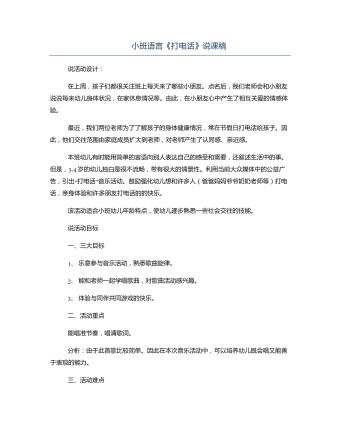
小班语言《打电话》说课稿
在上周,孩子们都很关注班上每天来了哪些小朋友。点名后,我们老师会和小朋友说说每来幼儿身体状况,在家休息情况等。由此,在小朋友心中产生了相互关爱的情感体验。最近,我们两位老师为了了解孩子的身体健康情况,常在节假日打电话给孩子。因此,他们交往范围由家庭成员扩大到老师,对老师产生了认同感、亲近感。本班幼儿有时能用简单的言语向别人表达自己的感受和需要,还叙述生活中的事。但是,3-4岁的幼儿独白是很不流畅,带有很大的情景性。利用当前大众媒体中的公益广告,引出“打电话”音乐活动。鼓励强化幼儿想和许多人(爸爸妈妈爷爷奶奶老师等)打电话,亲身体验和许多朋友打电话的的快乐。

